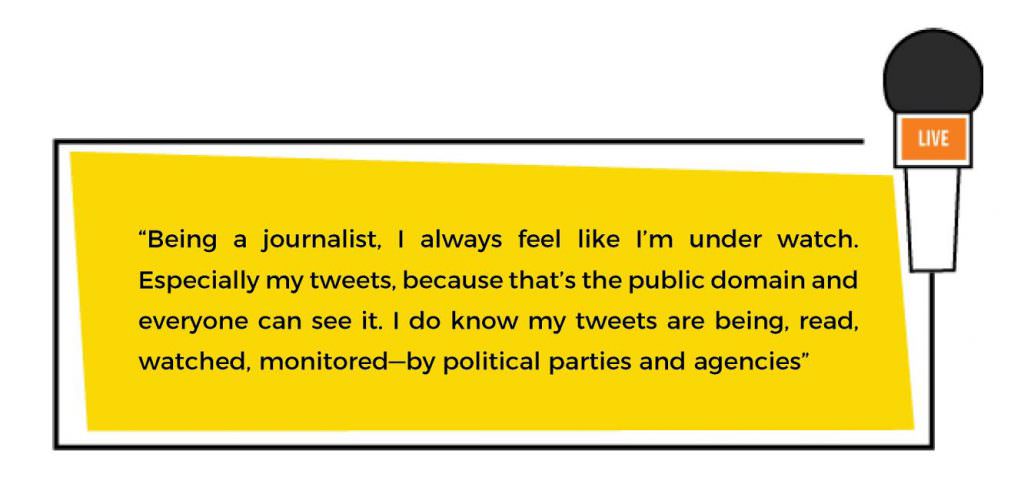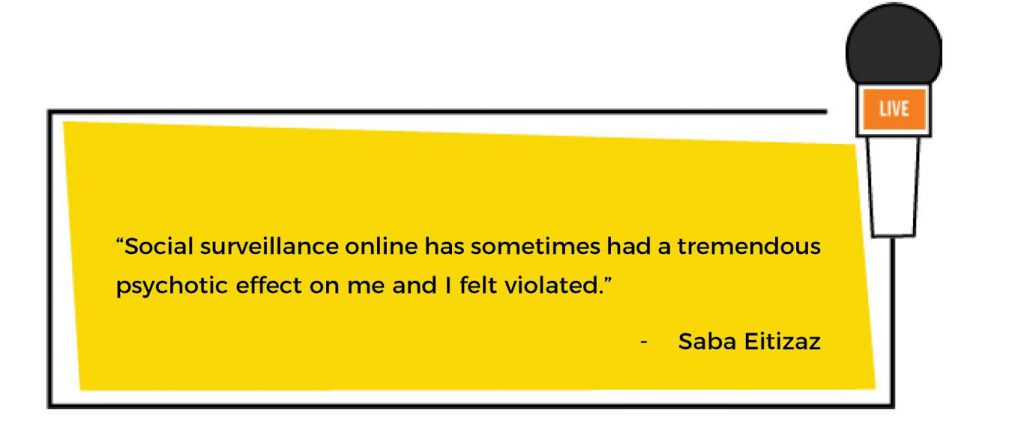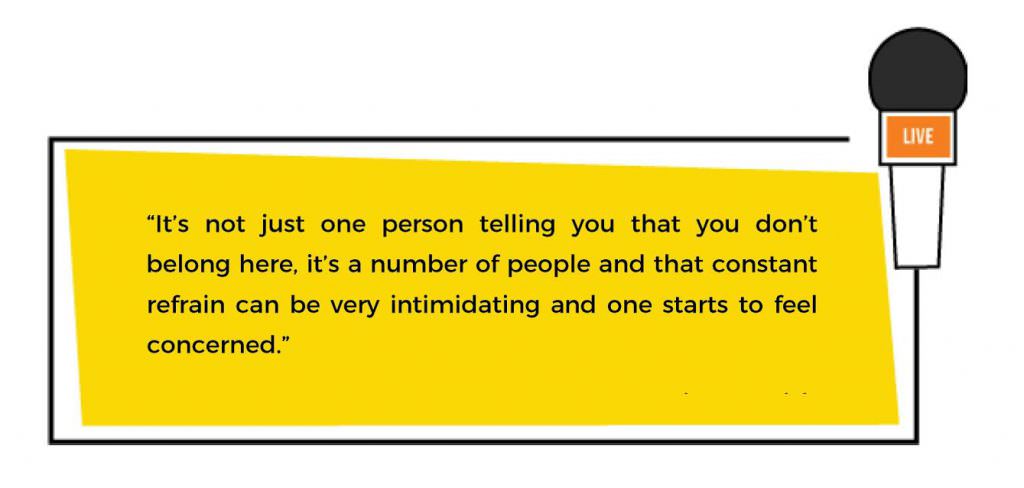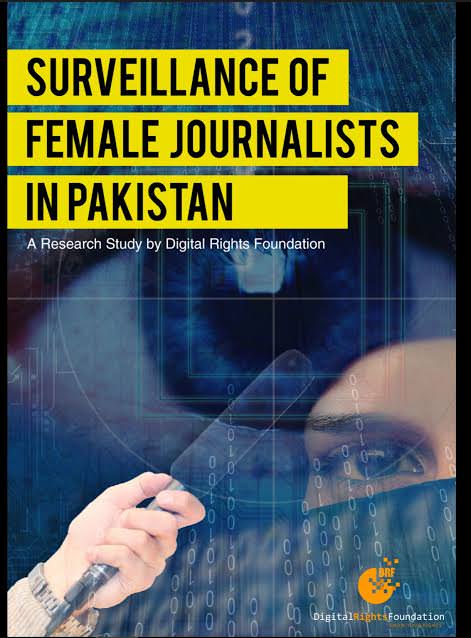Posted by Shmyla Khan
While being a journalist in any part of the world is not easy, being one in Pakistan can be downright dangerous. Pakistan is ranked as the fourth most dangerous country for journalists. With the passage of the Prevention of Electronic Crimes Act 2016 (commonly referred to as the Cybercrime Act), journalists fear that their speech and activities in online spaces will come under increased scrutiny. In this uncertain political and legal landscape, Digital Rights Foundation (DRF) set out to explore an often neglected part of the discussion around surveillance of journalists: gender. DRF has been dealing with individual cases of online harassment faced by female journalists and it had become obvious to us that the nature and level of threat is not uniform. The class, religion, work, sexual orientation and gender of the journalist determines the treatment they get from the state and their audience.
We sought to explore this intersectionality in its report titled Surveillance of Female Journalists in Pakistan. Through its activism and research, DRF aims to mainstream the concept of social surveillance as a form of surveillance. Traditional surveillance studies imagine surveillance and the experience of it as gender-neutral and primarily carried out by the state — a 1984-esque notion of what monitoring of human activity looks like. While state surveillance is a real concern, focusing on the lived experiences of female journalists revealed that the definition of surveillance could be widened to include private surveillance (or “social surveillance” as we like to call it).

Quote: Maria Memon, interviewee
DRF’s report builds upon in-depth qualitative interviews with seven women journalists from all across Pakistan. These women were a healthy mix of print, electronic and web journalists. The small sample size meant that the study does not make any claims to being representative of the larger experience of female journalists in the country, rather it posits itself as a pilot study on gendered surveillance and aims to start a larger conversation on the issue. The qualitative method of the interviews was particularly suited for exploring the complex dynamics and nuances of social surveillance. Female journalists make for particularly apt subjects for research on social and gendered surveillance given their unique and visible position in public discourse in both online and offline spaces.
We identified two main sources of surveillance experienced by female journalists in Pakistan: state and social. However, it is important to point out that these are not discrete categories and oftentimes the two work together in complicated ways to harass, threaten and monitor journalists.
State surveillance is carried out by the state, government, institutions and intelligence agencies. State surveillance is troubling given that it is backed by state machinery which makes for effective, systematic and efficient monitoring. However, given the clandestine nature in which state surveillance operates, it is very difficult to measure or describe in detail. This very uncertainty takes a psychological toll as many of our interviewees said that they felt “paranoid” when they saw some patterns appearing in their inbox or twitter mentions.
The second source of surveillance was social surveillance and was experienced by all the journalists we interviewed. Social surveillance is carried out by the audience, political parties and their supporters, non-state actors, fellow journalists and personal contacts. Some female journalists said that they had not experienced overt government surveillance or monitoring, however, they, on the other hand, had experienced social surveillance as an everyday extension of their profession. It is in light of these findings of social surveillance as a gendered phenomenon, we felt that it is particularly important to mainstream a definition of surveillance that not only includes state surveillance but social surveillance as well. Thus any definition that excludes social surveillance, in turn, silences female experiences of surveillance.

Quote: Saba Eitizaz, interviewee.
While it is difficult to conclude whether women face more surveillance than their male counterparts (or vice versa), it was obvious that the form that the surveillance takes is decidedly gendered: sexualised threats, attacks on character and their appearance. This gendered character is true for both state and social surveillance.
Key Research Findings
- Seven female journalists were interviewed for this study
- Surveillance is experienced differently based on the identity of the journalist
- Gendered surveillance comes from the state as well as society, sometimes a combination of the two
- Social surveillance is carried out by the audience, political parties and their supporters, non-state actors, fellow journalists and personal contacts
- Gendered surveillance manifests itself more in psychological forms as opposed to physical attacks (which is not to say that women do not face physical surveillance)
- Gendered surveillance concentrates on the person and sexuality of the female journalist, as opposed to their work
- Gendered surveillance takes a psychological toll on female journalists and also leads to a lot of self-censorship
- Certain topics, such as blasphemy laws, minority rights and civil-military relations lead to more surveillance in Pakistan
- Gendered surveillance is often left unaddressed in media organizations
Our study highlights that online social surveillance takes on a particularly gendered facet and the harassment is often specifically geared towards the person’s sexuality, appearance and character. Many female journalists observed that when it comes to controversial topics, both female and male journalists face equal levels of surveillance, however, the content of the threat tends to be different. In the experience of some journalists, even when the state is attempting to intimidate or discourage them from publishing or reporting particular materials, they often employ sexualized threats or the possibility of revealing facts about their personal lives that can result in social implications given their gender.

Quote: Kiran Nazish, interviewee.
The surveillance experienced by women is particularly psychological, as opposed to physical. This is not to say female journalists are not at physical risk; there are instances of sexualized violence and, in the case of Zeenat Shehzadi, enforced disappearances. Many of the journalists said they were guarded about what they said online for fear of surveillance and thus had to self-censor their opinions and at times their reporting. Some interviewees openly admitted that they avoided sharing controversial opinions online to avoid an inevitable barrage of abuse and personal comments.
- Editors, line managers, and media organizations need to take the toll of gendered surveillance seriously
- A collective approach to security and emotional support is needed among the journalist community
- Training and awareness sessions among journalists about online harassment, reporting mechanisms, and online safety
- Parliament needs to enact legislation for the protection of journalists
- Protections need to be extended to freelance journalists and bloggers
Several interviewees pointed out that line managers and editors either do not take gendered and psychological surveillance seriously or are unequipped to deal with it in a gender sensitive manner. On the basis of the report’s findings, DRF recommends that both the state and media houses need to take concrete steps towards protecting female journalists through increased cyber security, psychological support and legal assistance if they chose to pursue a cybercrime case. The first step, however, is identifying gendered surveillance for what it is.
Shmyla Khan is the head of the Cyber Harassment Helpline at Digital Rights Foundation and a lawyer by training. She co-authored the report mentioned in the article with her colleague, Luavut Zahid.
View the entire report here.
About the author(s)
Guest Writers are writers who occasionally write on FII.




